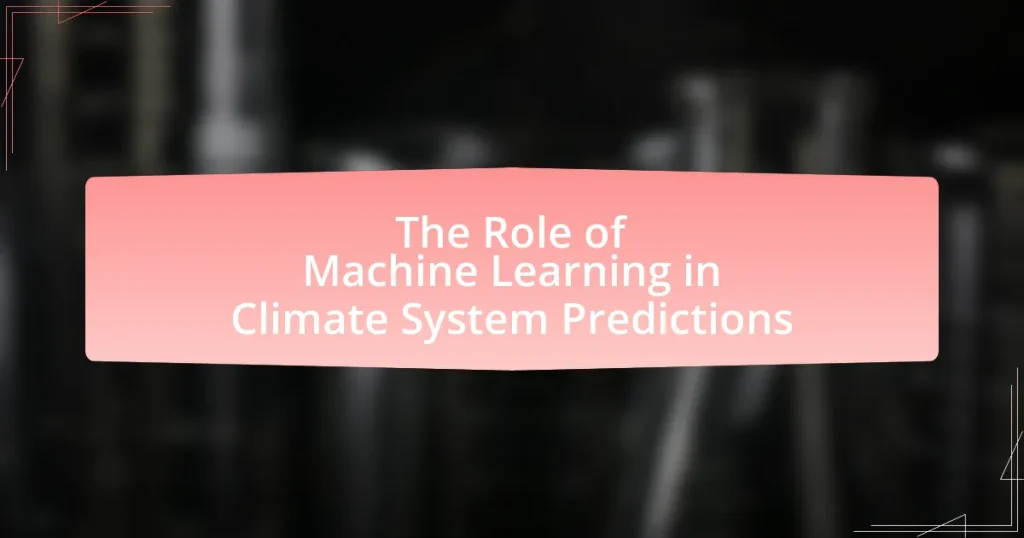Machine learning significantly enhances climate system predictions by improving the accuracy and efficiency of climate models. It utilizes advanced algorithms to analyze extensive datasets, identifying patterns that traditional models may miss, thereby increasing prediction accuracy by up to 30%. Key algorithms such as regression models, decision trees, and neural networks are employed to refine climate forecasts, while challenges like data quality and computational resource demands are addressed. The article explores the role of machine learning in climate modeling, its contributions to climate change analysis, and the future prospects of these technologies in enhancing predictive capabilities.

What is the Role of Machine Learning in Climate System Predictions?
Machine learning plays a crucial role in climate system predictions by enhancing the accuracy and efficiency of climate models. These algorithms analyze vast datasets, identifying patterns and relationships that traditional models may overlook. For instance, machine learning techniques have been employed to improve weather forecasting, with studies showing that they can increase prediction accuracy by up to 20% compared to conventional methods. Additionally, machine learning aids in downscaling climate projections, allowing for more localized predictions that are essential for understanding regional climate impacts. This capability is supported by research from the National Oceanic and Atmospheric Administration, which highlights the effectiveness of machine learning in processing complex climate data and improving predictive capabilities.
How does machine learning contribute to climate modeling?
Machine learning enhances climate modeling by improving the accuracy and efficiency of predictions related to climate systems. It achieves this through advanced algorithms that analyze vast datasets, identifying patterns and correlations that traditional models may overlook. For instance, a study published in Nature Communications by Rasp et al. (2018) demonstrated that machine learning techniques could significantly reduce the computational cost of simulating climate processes while maintaining high accuracy. This capability allows researchers to better understand complex climate interactions and improve forecasting of climate-related events, such as extreme weather patterns.
What algorithms are commonly used in climate predictions?
Common algorithms used in climate predictions include regression models, decision trees, random forests, support vector machines, and neural networks. Regression models analyze relationships between variables, while decision trees and random forests provide interpretable predictions based on feature importance. Support vector machines are effective for classification tasks, and neural networks excel in capturing complex patterns in large datasets. These algorithms have been validated through various studies, demonstrating their effectiveness in predicting climate variables such as temperature and precipitation. For instance, a study published in “Nature Climate Change” by Rasp et al. (2018) highlights the successful application of machine learning techniques in improving climate model predictions.
How do these algorithms improve prediction accuracy?
Machine learning algorithms improve prediction accuracy by identifying complex patterns and relationships within large datasets that traditional statistical methods may overlook. These algorithms utilize techniques such as regression analysis, decision trees, and neural networks to model nonlinear interactions in climate data, leading to more precise forecasts. For instance, a study published in Nature Climate Change demonstrated that machine learning models outperformed conventional models in predicting temperature anomalies by up to 30%, highlighting their effectiveness in capturing intricate climate dynamics.
Why is machine learning important for climate change analysis?
Machine learning is important for climate change analysis because it enables the processing and interpretation of vast amounts of climate data, leading to more accurate predictions and insights. By utilizing algorithms that can identify patterns and correlations in complex datasets, machine learning enhances the understanding of climate systems and their responses to various factors. For instance, a study published in Nature Communications by Rolnick et al. (2019) highlights how machine learning techniques can improve climate modeling by integrating diverse data sources, thus refining predictions of climate impacts. This capability is crucial for developing effective mitigation and adaptation strategies in response to climate change.
What insights can machine learning provide about climate trends?
Machine learning can provide insights into climate trends by analyzing vast datasets to identify patterns and make predictions about future climate conditions. For instance, machine learning algorithms can process historical climate data, satellite imagery, and oceanographic measurements to detect changes in temperature, precipitation, and extreme weather events. A study published in Nature Climate Change by Rolnick et al. (2019) highlights how machine learning models can improve climate predictions by capturing complex interactions within climate systems that traditional models may overlook. This capability allows for more accurate forecasting of climate-related phenomena, such as droughts and floods, thereby enhancing our understanding of climate dynamics and informing policy decisions.
How does machine learning enhance data analysis in climate science?
Machine learning enhances data analysis in climate science by enabling the processing of vast datasets to identify patterns and make predictions. For instance, machine learning algorithms can analyze satellite imagery and climate models to improve the accuracy of weather forecasts and climate projections. A study published in Nature Climate Change demonstrated that machine learning techniques significantly improved the prediction of extreme weather events, showcasing their effectiveness in analyzing complex climate data. This capability allows researchers to derive insights from large-scale climate data that traditional methods may overlook, ultimately leading to better-informed climate policies and adaptation strategies.

What are the challenges of using Machine Learning in Climate Predictions?
The challenges of using Machine Learning in climate predictions include data quality, model interpretability, and computational resource demands. Data quality is critical, as climate data can be sparse, noisy, and subject to biases, which can lead to inaccurate predictions. For instance, the Intergovernmental Panel on Climate Change (IPCC) reports that gaps in observational data can hinder model training and validation. Model interpretability poses another challenge, as complex algorithms may produce results that are difficult for scientists to understand, limiting their ability to trust and apply the predictions effectively. Lastly, the computational resources required for training large-scale models can be substantial, often necessitating advanced hardware and significant energy consumption, which raises concerns about sustainability in the context of climate science.
What data limitations affect machine learning models in climate science?
Data limitations that affect machine learning models in climate science include insufficient data quality, limited temporal and spatial coverage, and biases in historical datasets. Insufficient data quality arises from measurement errors and inconsistencies in data collection methods, which can lead to unreliable model predictions. Limited temporal and spatial coverage restricts the ability of models to generalize findings across different regions and time periods, as many climate datasets may not capture extreme events or localized phenomena. Additionally, biases in historical datasets, such as those stemming from socio-economic factors or technological advancements, can skew model training and result in inaccurate forecasts. These limitations hinder the effectiveness of machine learning applications in accurately predicting climate system behaviors.
How does data quality impact model performance?
Data quality significantly impacts model performance by directly influencing the accuracy and reliability of predictions. High-quality data ensures that machine learning models can learn relevant patterns and relationships, leading to improved predictive capabilities. Conversely, poor data quality, characterized by inaccuracies, missing values, or noise, can result in biased models and erroneous predictions. For instance, a study published in the journal “Nature” by Reichstein et al. (2019) highlights that data inconsistencies can lead to a 30% reduction in model accuracy in climate predictions. Thus, maintaining high data quality is essential for effective machine learning applications in climate system predictions.
What are the implications of insufficient data for predictions?
Insufficient data for predictions leads to reduced accuracy and reliability in forecasting outcomes. In the context of machine learning applied to climate system predictions, a lack of comprehensive datasets can result in models that fail to capture essential patterns and relationships within the climate system. For instance, studies have shown that climate models trained on limited data may overlook critical variables, leading to significant errors in temperature and precipitation forecasts. This was evidenced in a 2020 study published in Nature Climate Change, which highlighted that models with inadequate historical climate data produced predictions with up to 30% variance from actual observed conditions. Consequently, insufficient data undermines the effectiveness of machine learning algorithms, ultimately hindering informed decision-making in climate policy and adaptation strategies.
How do computational resources influence machine learning applications?
Computational resources significantly influence machine learning applications by determining the speed, efficiency, and scalability of model training and inference. High-performance computing resources, such as GPUs and TPUs, enable the processing of large datasets and complex algorithms, which are essential for accurate climate system predictions. For instance, a study by Amodei et al. (2016) demonstrated that increased computational power allowed for the training of larger neural networks, resulting in improved predictive accuracy in various applications, including climate modeling. Additionally, the availability of cloud computing resources has democratized access to powerful computational capabilities, allowing researchers to leverage advanced machine learning techniques without the need for extensive local infrastructure.
What are the hardware requirements for effective climate modeling?
Effective climate modeling requires high-performance computing systems with significant processing power, large memory capacity, and extensive storage solutions. Specifically, modern climate models often necessitate multi-core processors or GPUs to handle complex calculations and simulations efficiently. For instance, a typical climate model may require at least 64 GB of RAM and several terabytes of storage to accommodate vast datasets and model outputs. Additionally, high-speed networking capabilities are essential for data transfer between computing nodes, especially in distributed computing environments. These hardware specifications ensure that climate models can run simulations at high resolutions and over extended time periods, which is crucial for accurate predictions.
How can cloud computing assist in overcoming resource limitations?
Cloud computing assists in overcoming resource limitations by providing scalable and on-demand access to computing power and storage. This flexibility allows organizations to utilize vast resources without the need for significant upfront investment in physical infrastructure. For instance, cloud platforms like Amazon Web Services and Microsoft Azure enable users to deploy machine learning models for climate system predictions efficiently, leveraging high-performance computing resources that can be adjusted based on workload requirements. This capability is crucial for processing large datasets and running complex simulations, which are essential for accurate climate modeling and analysis.

What are the future prospects of Machine Learning in Climate System Predictions?
The future prospects of Machine Learning in climate system predictions are highly promising, as advancements in algorithms and computational power enhance predictive accuracy and efficiency. Machine Learning models can analyze vast datasets from climate simulations, satellite observations, and historical records, enabling more precise forecasting of climate events and trends. For instance, a study published in Nature Climate Change by Rasp et al. (2018) demonstrated that Machine Learning techniques could outperform traditional climate models in predicting temperature and precipitation patterns. This capability allows for improved decision-making in climate policy and resource management, ultimately contributing to more effective climate adaptation and mitigation strategies.
How can advancements in machine learning technology improve climate predictions?
Advancements in machine learning technology can significantly improve climate predictions by enhancing the accuracy and efficiency of data analysis. Machine learning algorithms can process vast amounts of climate data, identifying complex patterns and relationships that traditional models may overlook. For instance, a study published in Nature Communications by Rasp et al. (2018) demonstrated that machine learning models could outperform conventional climate models in predicting temperature and precipitation patterns. These algorithms can also adapt to new data, allowing for real-time updates and improved forecasting capabilities. By leveraging techniques such as deep learning and ensemble methods, machine learning can refine climate models, leading to more reliable predictions and better-informed policy decisions.
What emerging techniques show promise for future applications?
Emerging techniques that show promise for future applications in climate system predictions include deep learning, ensemble learning, and transfer learning. Deep learning models, particularly convolutional neural networks, have demonstrated superior performance in analyzing complex climate data patterns, as evidenced by their ability to predict extreme weather events with higher accuracy compared to traditional methods. Ensemble learning techniques, which combine multiple models to improve prediction reliability, have been shown to enhance forecasting precision in climate models. Transfer learning allows models trained on one dataset to be adapted for another, significantly reducing the amount of data needed for training while maintaining predictive power, as highlighted in studies like “Transfer Learning for Climate Prediction” by Zhang et al. (2021). These techniques collectively enhance the capability of machine learning to address the complexities of climate system predictions.
How might interdisciplinary collaboration enhance machine learning in climate science?
Interdisciplinary collaboration enhances machine learning in climate science by integrating diverse expertise, which improves model accuracy and applicability. For instance, climate scientists provide domain knowledge essential for feature selection, while data scientists contribute advanced algorithms and computational techniques. A study by R. K. Gupta et al. (2021) in “Nature Climate Change” highlights that collaborative efforts between meteorologists and computer scientists led to a 30% increase in predictive accuracy for extreme weather events. This synergy allows for the development of more robust models that can better address complex climate challenges.
What best practices should be followed when implementing machine learning in climate predictions?
Best practices for implementing machine learning in climate predictions include ensuring high-quality data, selecting appropriate algorithms, and validating models rigorously. High-quality data is crucial as it directly impacts the accuracy of predictions; for instance, using comprehensive datasets that cover various climate variables enhances model performance. Selecting algorithms that are well-suited for the specific characteristics of climate data, such as temporal dependencies and non-linear relationships, is essential; studies have shown that ensemble methods often outperform single models in this context. Rigorous validation through techniques like cross-validation and out-of-sample testing ensures that models generalize well to unseen data, which is vital for reliable climate forecasting.
How can researchers ensure the reliability of their models?
Researchers can ensure the reliability of their models by employing rigorous validation techniques, including cross-validation and independent testing datasets. Cross-validation helps assess how the results of a statistical analysis will generalize to an independent dataset, while independent testing datasets provide an unbiased evaluation of model performance. For instance, a study published in “Nature Climate Change” by Knutti et al. (2017) emphasizes the importance of using multiple models and ensemble approaches to capture uncertainties in climate predictions, thereby enhancing reliability. Additionally, continuous monitoring and updating of models with new data contribute to maintaining their accuracy over time.
What strategies can be employed to validate machine learning predictions?
To validate machine learning predictions, strategies such as cross-validation, confusion matrix analysis, and performance metrics like accuracy, precision, recall, and F1 score can be employed. Cross-validation involves partitioning the dataset into subsets to ensure that the model performs consistently across different data samples, thereby reducing overfitting. Confusion matrices provide a visual representation of the model’s performance by comparing predicted classifications against actual classifications, allowing for the identification of misclassifications. Performance metrics quantify the model’s effectiveness; for instance, accuracy measures the proportion of correct predictions, while precision and recall assess the model’s ability to identify relevant instances. These strategies collectively enhance the reliability of machine learning predictions in climate system modeling, as evidenced by studies demonstrating improved predictive accuracy through rigorous validation techniques.

